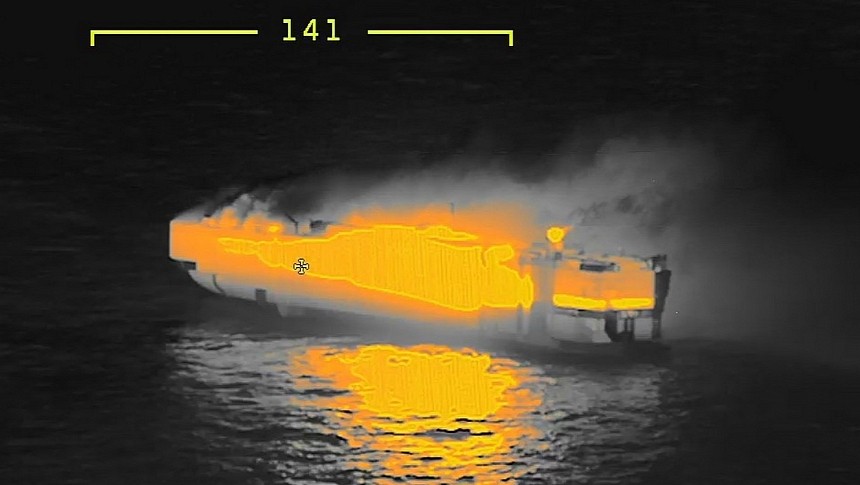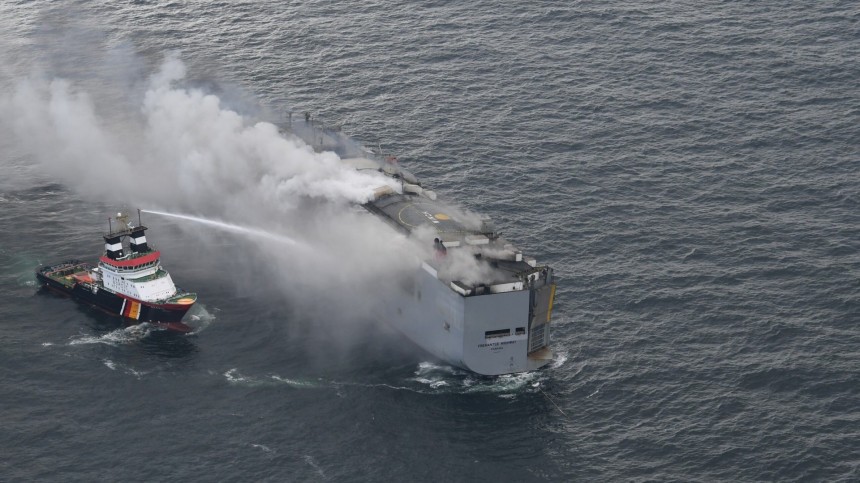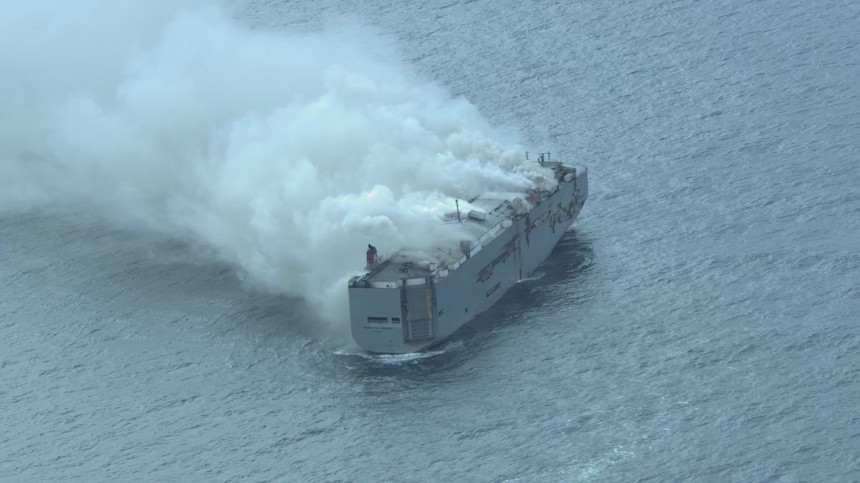On February 16, 2022, a fire broke out inside the Felicity Ace. This roll-on/roll-off (RoRo) cargo ship was carrying 3,965 cars from the Volkswagen group to the US. Several battery electric vehicles (BEVs) were also inside, which made captain João Mendes Cabeças comment it was really hard to kill the fire. As the ship capsized and sank, it was never determined what caused the blaze. We are now seeing a similar event with the Fremantle Highway – and the same questions the Felicity Ace posed.
If you are not aware of the Japanese RoRo cargo ship, the Fremantle Highway left the Bremerhaven port in Germany to reach Singapore. On July 26, when it was close to the Dutch island of Ameland, a fire broke out inside the vessel. Unlike the Felicity Ace, one member of the Fremantle Highway's crew died. Nobody talked about what killed the seafarer, but there are reports of an explosion on the ship and that 7 of the 25 crew members had to jump from the boat. Considering how tall these vessels are, the sailors that jumped hit the water at speeds of around 130 kph (81 mph), which can be fatal. That is another possible cause of the crew member's death. Sal Mercogliano, from the "What is Going on With Shipping" YouTube channel, said the fall was what killed this sailor. Although he seems to be a reliable source, we have yet to confirm that.
The Fremantle Highway was carrying 3,783 new cars, and 498 of them were BEVs. At first, it was said that the fire was caused by one of these electric cars, but the Dutch Coast Guard denied that was for sure. At this point, that is the least of the concerns the whole thing presents. After all, the fire could have started for any reason. It is having BEVs on board that makes everything more complicated. If these vehicles are affected, the fire will be almost certainly out of control until the battery packs burn to the ground.
The reason for that is chemical: the ternary cells that are used in most battery packs are composed of oxides. When they burn, they release the very oxygen that keeps fires alive and which firefighters try to avoid with water, carbon dioxide, dry chemical, foam water, or any other means that "cut communication" between the gas and whatever is combusting. This is why blazes involving BEVs are extremely difficult to kill. Now imagine that multiplied by 498. How will RoRo ships deal with that danger in an effective way?
Importing and exporting batteries is a challenging deal. Not long ago, selling BEVs only made sense where they were produced because of the risks involved with transporting them. With many governments pushing for BEV adoption, the markets that do not manufacture these cars probably changed legislation to make that easier. If that were not the case, transportation costs would make them even less competitive with internal combustion engine (ICE) vehicles.
According to Mercogliano, RoRo ships have massive carbon dioxide reservoirs that flood the closed decks where fires may start and kill blazes in them quite rapidly. As I explained earlier, that makes no difference with EVs because they produce the oxygen the carbon dioxide would prevent from reaching the fires. Apart from being a former merchant mariner, he was also a firefighter. In his opinion, BEVs are undoubtedly making RoRo fires worse. With more plastic material in their bodies to save weight and massive battery packs, car carriers are "exceptionally dangerous" these days.
So there you have it: car technology evolved, but we are using the same old means to transport them. Mercogliano said car carriers were already dangerous due to stability issues, which could even make a boat roll over. Ship companies have to conceive new vessels to transport electric cars, which will take years to happen. Constructing a massive ship is difficult and time-consuming per se. Still, the problem is even more profound: shipbuilders will have to design them to be safer and to deal with things that do not need oxygen to burn because they carry their own reserves of this gas.
Again, knowing what started a fire in a RoRo ship is not relevant. If that blaze happens to affect any BEV, even if it is just one, things will get ugly for anyone trying to extinguish the mess in a vessel. If they are many more, there is a very slim chance that the cargo or the ship will survive. As the Fremantle Highway sadly demonstrated, even the crews may not return home. If we are to promote the BEV shift, that has to be urgently considered and addressed – even if we take years to solve these concerns for good. Ignoring the problem or dismissing BEVs as fire causes makes absolutely no difference to the nasty outcomes that derive from simply carrying them.
The Fremantle Highway was carrying 3,783 new cars, and 498 of them were BEVs. At first, it was said that the fire was caused by one of these electric cars, but the Dutch Coast Guard denied that was for sure. At this point, that is the least of the concerns the whole thing presents. After all, the fire could have started for any reason. It is having BEVs on board that makes everything more complicated. If these vehicles are affected, the fire will be almost certainly out of control until the battery packs burn to the ground.
The reason for that is chemical: the ternary cells that are used in most battery packs are composed of oxides. When they burn, they release the very oxygen that keeps fires alive and which firefighters try to avoid with water, carbon dioxide, dry chemical, foam water, or any other means that "cut communication" between the gas and whatever is combusting. This is why blazes involving BEVs are extremely difficult to kill. Now imagine that multiplied by 498. How will RoRo ships deal with that danger in an effective way?
According to Mercogliano, RoRo ships have massive carbon dioxide reservoirs that flood the closed decks where fires may start and kill blazes in them quite rapidly. As I explained earlier, that makes no difference with EVs because they produce the oxygen the carbon dioxide would prevent from reaching the fires. Apart from being a former merchant mariner, he was also a firefighter. In his opinion, BEVs are undoubtedly making RoRo fires worse. With more plastic material in their bodies to save weight and massive battery packs, car carriers are "exceptionally dangerous" these days.
So there you have it: car technology evolved, but we are using the same old means to transport them. Mercogliano said car carriers were already dangerous due to stability issues, which could even make a boat roll over. Ship companies have to conceive new vessels to transport electric cars, which will take years to happen. Constructing a massive ship is difficult and time-consuming per se. Still, the problem is even more profound: shipbuilders will have to design them to be safer and to deal with things that do not need oxygen to burn because they carry their own reserves of this gas.
































